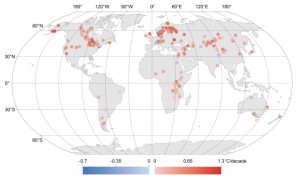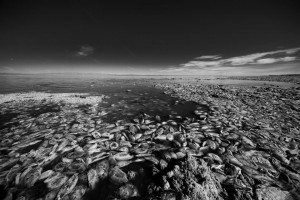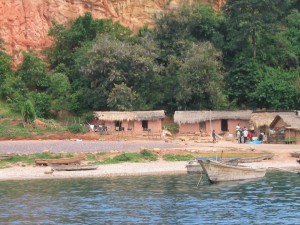More than half world’s freshwater supplies measured
16 December 2015

Lakes are warming at a global average of 0.34 degrees Celsius per decade (0.61 degrees Fahrenheit per decade).
Credit: American Geophysical Union, O’Reilly et al. 2015
SAN FRANCISCO — Climate change is rapidly warming lakes around the world, threatening freshwater supplies and ecosystems, according to a new study spanning six continents.
The study is the largest of its kind and the first to use a combination of satellite temperature data and long-term ground measurements. A total of 235 lakes, representing more than half of the world’s freshwater supply, were monitored for at least 25 years. The research, published in Geophysical Research Letters, a journal of the American Geophysical Union, was announced today at the 2015 American Geophysical Union Fall Meeting.
The study, which was funded by NASA and the National Science Foundation, found lakes are warming an average of 0.61 degrees Fahrenheit (0.34 degrees Celsius) each decade. That’s greater than the warming rate of either the ocean or the atmosphere, and it can have profound effects, the scientists say.
Algal blooms, which can ultimately rob water of oxygen, are projected to increase 20 percent in lakes over the next century as warming rates increase. Algal blooms that are toxic to fish and animals would increase by 5 percent. If these rates continue, emissions of methane, a greenhouse gas 25 times more powerful than carbon dioxide on 100-year time scales, will increase 4 percent over the next decade.

Warming can reduce the amount of oxygen available to fish and other animals in lakes, and this situation can become especially problematic when a lake is also receiving nutrient pollution that increases algal blooms and ultimately depletes oxygen further. In the Salton Sea, fish kills occur when warm temperature, strong wind and high algal production converge and expose the fish to very low oxygen.
Credit: Flickr|Ian Norman
“Society depends on surface water for the vast majority of human uses,” said Stephanie Hampton, director of Washington State University’s Center for Environmental Research, Education and Outreach in Pullman, and co-author of the study. “Not just for drinking water, but manufacturing, for energy production, for irrigation of our crops. Protein from freshwater fish is especially important in the developing world.”
The temperature of water influences a host of its other properties critical to the health and viability of ecosystems. When temperature swings quickly and widely from the norm, life forms in a lake can change dramatically and even disappear.
“‘These results suggest that large changes in our lakes are not only unavoidable, but are probably already happening,” said Catherine O’Reilly, an associate professor of geology at Illinois State University, Normal, and lead author of the study. Earlier research by O’Reilly has seen declining productivity in lakes with rising temperatures.
Temperature increases close to or above the average .61 degrees Fahrenheit rise were seen in some of the world’s most popular waters, including Lake Tahoe (+.97 Fahrenheit by hand, +1.28 by satellite), the Dead Sea (+1.13 Fahrenheit), two reservoirs serving New York City, Seattle’s Lake Washington (+.49 Fahrenheit), and the Great Lakes Huron (+1.53 Fahrenheit by hand, +.79 by satellite), Michigan (+.76 Fahrenheit by hand, +.36 by satellite), Ontario (+.59 Fahrenheit) and Superior (+2.09 Fahrenheit by hand measurement, +1.44 Fahrenheit by satellite).
Simon Hook, science division manager at NASA’s Jet Propulsion Laboratory in in Pasadena, California, and another co-author of the study, said satellite measurements provide a broad view of lake temperatures over the entire globe. But they only measure surface temperature, while hand measurements can detect temperature changes throughout a lake. Also, while satellite measurements go back 30 years, some lake measurements go back more than a century.
“Combining the ground and satellite measurements provides the most comprehensive view of how lake temperatures are changing around the world,” he said.
The researchers said various climate factors are associated with the warming trend. In northern climates, lakes are losing their ice cover earlier, and many areas of the world have less cloud cover, exposing their waters more to the sun’s warming rays.
Previous work by Hook using satellite data indicated that many lake temperatures were warming faster than air temperature and that the greatest warming was observed at high latitudes, as seen in other climate warming studies. This new research confirmed those observations, with average warming rates of 1.3 degrees Fahrenheit (0.72 degrees Celsius) per decade at high latitudes.

In other lakes, such as Lake Tanganyika in East Africa, we have seen that rising temperature has had a very different effect, reducing the productivity because rising temperature reduce the lake’s ability to distribute nutrients that feed algal growth – in this case, reduced productivity may reduce the amount of food available to fish.
Credit: Catherine O’Reilly
Warm-water, tropical lakes may be seeing less dramatic temperature increases, but increased warming of these lakes can still have large negative impacts on fish. That can be particularly important in the African Great Lakes, where fish is an important source of food.
“We want to be careful that we don’t dismiss some of these lower rates of change,” said Hampton. “In warmer lakes, those temperature changes can be really important. They can be just as important as a higher rate of change in a cooler lake.”
In general, the researchers write, “The pervasive and rapid warming observed here signals the urgent need to incorporate climate impacts into vulnerability assessments and adaptation efforts for lakes.”
###
The American Geophysical Union is dedicated to advancing the Earth and space sciences for the benefit of humanity through its scholarly publications, conferences, and outreach programs. AGU is a not-for-profit, professional, scientific organization representing more than 60,000 members in 139 countries. Join the conversation on Facebook, Twitter, YouTube, and our other social media channels.
Notes for Journalists
Journalists and public information officers (PIOs) of educational and scientific institutions who have registered with AGU can download a PDF copy of the article by clicking on this link:
http://onlinelibrary.wiley.com/doi/10.1002/2015GL066235/full?campaign=wlytk-41855.5282060185
Or, you may order a copy of the final paper by emailing your request to Lillian Steenblik Hwang at [email protected]. Please provide your name, the name of your publication, and your phone number.
Neither the paper nor this press release is under embargo.
“Rapid and highly variable warming of lake surface waters around the globe”
Below are the joint first authors of the paper. For a complete list of authors, please see the article.
Catherine M. O’Reilly: Department of Geography-Geology, Illinois State University, Normal, Illinois, USA;
Sapna Sharma: Department of Biology, York University, Toronto, Ontario, Canada;
Derek K. Gray: Department of Biological and Environmental Sciences, California University of Pennsylvania, USA;
Stephanie E. Hampton: Center for Environmental Research, Education and Outreach, Washington State University, Washington, USA.
Contact Information for the Authors:
Catherine O’Reilly: [email protected]
Stephanie Hampton: [email protected]
Simon Hook: [email protected]
WSU’s Eric Sorensen can arrange interviews with Stephanie Hampton and Catherine O’Reilly, and NASA JPL’s Alan Buis can arrange interviews with Simon Hook.
Lillian Steenblik Hwang
+1 (202) 777-7318
[email protected]
Washington State University contact:
Eric Sorensen
+1 (509) 335-4846
[email protected]
NASA Jet Propulsion Laboratory contact:
Alan Buis
+1 (818) 354-0474
[email protected]
National Science Foundation contact:
Cheryl Dybas
+1 (703) 306-1070
[email protected]